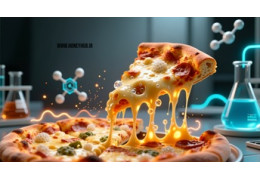Does your mozzarella refuse to stretch or just burn? The secret is science. From "pasta filata" to the crucial role...
The Secret to Perfect Mozzarella: A Scientific Dive into Pizza Cheese
We've all been there: you pull a pizza from the oven, but instead of a glorious cheese pull, you get a rubbery, clumpy mess that’s either burnt or swimming in a pool of oil. It’s a common kitchen frustration. But the secret to a perfect, stretchy, golden-brown mozzarella isn’t luck or brand loyalty; the answer lies in food science and a surprisingly precise manufacturing process.
In this article, we'll dive into the science of mozzarella to understand exactly what makes it the undisputed king of pizza and how you can use that knowledge to make smarter choices at the store and in the kitchen.
The Big Question: Why Is “Fresh” Mozzarella Terrible for Pizza?
This is the biggest misunderstanding about mozzarella. You buy those soft, white balls of fresh mozzarella (like bocconcini) floating in brine, thinking "fresh" and "authentic" must be better. While that cheese is perfect for a Caprese salad, using it on a standard pizza is a common mistake. Why?
- Too Much Moisture: Fresh mozzarella is 52-60% water. In the oven's heat, this water is released, turning your pizza crust into a soggy, doughy mess.
- The Wrong Protein Structure: The cheese we need for pizza is "aged." We'll explain below why this "aging" process is the most important secret to getting that perfect stretch.
The cheese you actually need for pizza is called Low-Moisture Part-Skim (LMPS) Mozzarella. This is the firm, cream-colored block (or pre-shredded bag) sold as "pizza cheese" in the grocery store.
The "Pasta Filata" Magic: What Makes Mozzarella, Mozzarella?
What makes mozzarella unique is an Italian process called "Pasta Filata," which means "pulled paste" or "spun curd." In this step, the cheese curds are heated in hot water (around 150-170°F or 65-75°C), then kneaded and stretched.
This mechanical stretching is crucial. It changes the molecular structure of the proteins (casein), aligning them from a tangled mess into long, parallel, fibrous strands. This is the *exact* structure that gives mozzarella its amazing stretch when melted.
Interestingly, this process was originally designed for a very different milk. Authentic Italian *Mozzarella di Bufala* is traditionally made from the milk of the water buffalo, which is richer and higher in fat and protein. This creates a distinct texture and flavor. (If you're curious about this original milk, you can read about "Buffalo milk: a rich source of nutrients and therapeutic properties".) Today, cheesemakers have to use science to replicate these properties with standard cow's milk.

Secret #1: Why Won't My Cheese Stretch? (The Science of Aging)
This is the most critical takeaway for any home cook. Even the correct LMPS (pizza cheese) is *not* ready for pizza immediately after it's made.
Cheese that has just finished the "pasta filata" process is *too* elastic. If you melt it, it snaps back like a rubber band instead of stretching.
The solution? Patience. The cheese must be "aged" (or ripened) in a refrigerator for 2 to 4 weeks. During this time, leftover enzymes slowly begin to break down the protein network. (This process is called proteolysis.)
The result: This process reduces the cheese's rubbery elasticity and makes it softer and more "viscous" (flowable). When you heat this aged cheese, it melts beautifully and gains that perfect, incredible stretch. Perfect mozzarella is a product that has been carefully aged.
Secret #2: Why Does My Cheese Burn? (The Science of Sugars)
Those desirable golden-brown spots on pizza are great, but a burnt, blackened top is a defect. This burning is caused by the Maillard Reaction—a chemical reaction between amino acids (from protein) and "reducing sugars" at high heat.
The main sugars in cheese are lactose and its byproduct, galactose. If too much of this sugar remains in the final cheese, it will burn and blacken long before the rest of your pizza is perfectly cooked.
The (Factory) Solution: Professional cheesemakers use specific starter cultures (like certain strains of *Streptococcus thermophilus*) that are very efficient at consuming not just the lactose, but also the galactose, during the manufacturing process. This ensures the cheese will brown perfectly to a golden color instead of burning.
Buying Guide: Which Mozzarella for What Dish?
Choosing the right cheese for the right application is the key to culinary success. This table breaks down your options:
| Cheese Type | Moisture | Key Characteristic | Best Use |
|---|---|---|---|
| Fresh Mozzarella (Bocconcini/Ciliegine) | High (52-60%) | Soft, delicate, strong milky flavor | Caprese salad, eating cold, Neapolitan pizza (added at end) |
| Mozzarella di Bufala (Authentic) | High | Very rich, higher fat, stronger flavor | Eating cold, luxury pizzas |
| Low-Moisture (LMPS) Mozzarella | Medium (45-52%) | Firm, great shredding, ideal melt and stretch | American-style pizza, lasagna, baked dishes |
| String Cheese | Medium | Very strong, aligned fibrous structure | Snack (eaten cold) |
Chef's Tip: Going Beyond Pizza
Now that you understand the science behind mozzarella, you can use it more creatively. In professional kitchens, balancing flavor is everything. The mild saltiness of melted mozzarella is a perfect canvas for contrasting flavors.
One of the biggest trends right now is "Hot Honey Pizza." The combination of salty pepperoni and cheese with the sweet kick of natural honey and a little heat from chili flakes creates a complex and memorable flavor experience. It shows how understanding your ingredients allows you to push culinary boundaries.
Frequently Asked Questions About Mozzarella
Why does my pizza cheese get watery instead of stretchy?
This is almost always a moisture problem. You likely used fresh mozzarella (for salads) instead of low-moisture mozzarella (for pizza). Always choose the LMPS (pizza cheese) block or shreds for baking.
Can I freeze mozzarella cheese?
Yes, but carefully. Low-moisture mozzarella (the pizza block) freezes best. The ideal method is to shred the cheese, spread it on a baking sheet to freeze individually (IQF), and then bag it. Repeated freezing and thawing can damage the protein structure and reduce its stretch.
What's the secret to restaurant pizza cheese that stretches so much?
Besides using high-quality, properly-aged LMPS cheese, they use extremely hot ovens (often over 750°F / 400°C). This high heat melts the cheese instantly, bringing out its maximum stretch performance before the water evaporates or the sugars can burn.





















Latest comments